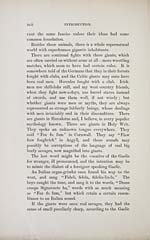Download files
Complete book:
Individual page:
Thumbnail gallery: Grid view | List view

INTRODUCTION. XCUl
tales, as they had in all others which treat of them, and
they ate their captives, as it is asserted that the early in-
habitants of Scotland did, as Herodotus says that Scyths
did in his time, and as the Feejee islanders did very
lately, and still do. A relative of mine once offered
me a tooth as a relic of such a feast ; it had been
presented to him in the Feejee islands by a charming
dark young lady, who had just left the banquet, but
had not shared in it. The Highland giants were not so
big but that their conquerors wore their clothes ; they
were not so strong that men could not beat them, even
by Avrestling. They were not quite savages ; for though
some lived in caves, others had houses and cattle, and
hoards of spoil. They had slaves, as we are told that
Scotch proprietors had within historic times. In
"Scotland in the Middle Ages," p. 141, Ave learn that
Earl AValdev of Dunbar made over a whole tribe to the
Abbot of Kelso in 1170, and in the next page it is im-
plied that these slaves were mostly Celts. Perhaps those
Celts who were not enslaved had their own mountain
view of the matter, and looked down on the Gall as
intrusive, savage, uncultivated, slave-owning giants.
Perhaps the mountain mists in like manner im-
peded the view of the dwellers on the mountain and
the plain, for Fin MacCoul was a " God in Ireland,"
as they say, and is a " rawhead and bloody bones " in
the Scottish lowlands now.
Whatever the giants were they knew some magic
arts, but they were always beaten in the end by men.
The combats with them are a Gaelic proverb in
action : —
" Theid seoltachd thar spionnaidb."
Skill goes over might, and probaljly, as it seems to
tales, as they had in all others which treat of them, and
they ate their captives, as it is asserted that the early in-
habitants of Scotland did, as Herodotus says that Scyths
did in his time, and as the Feejee islanders did very
lately, and still do. A relative of mine once offered
me a tooth as a relic of such a feast ; it had been
presented to him in the Feejee islands by a charming
dark young lady, who had just left the banquet, but
had not shared in it. The Highland giants were not so
big but that their conquerors wore their clothes ; they
were not so strong that men could not beat them, even
by Avrestling. They were not quite savages ; for though
some lived in caves, others had houses and cattle, and
hoards of spoil. They had slaves, as we are told that
Scotch proprietors had within historic times. In
"Scotland in the Middle Ages," p. 141, Ave learn that
Earl AValdev of Dunbar made over a whole tribe to the
Abbot of Kelso in 1170, and in the next page it is im-
plied that these slaves were mostly Celts. Perhaps those
Celts who were not enslaved had their own mountain
view of the matter, and looked down on the Gall as
intrusive, savage, uncultivated, slave-owning giants.
Perhaps the mountain mists in like manner im-
peded the view of the dwellers on the mountain and
the plain, for Fin MacCoul was a " God in Ireland,"
as they say, and is a " rawhead and bloody bones " in
the Scottish lowlands now.
Whatever the giants were they knew some magic
arts, but they were always beaten in the end by men.
The combats with them are a Gaelic proverb in
action : —
" Theid seoltachd thar spionnaidb."
Skill goes over might, and probaljly, as it seems to
Set display mode to: Large image | Transcription
Images and transcriptions on this page, including medium image downloads, may be used under the Creative Commons Attribution 4.0 International Licence unless otherwise stated. ![]()
| Early Gaelic Book Collections > Matheson Collection > Popular tales of the west Highlands > Volume 1 > (113) |
|---|
| Permanent URL | https://digital.nls.uk/81388584 |
|---|
| Description | Volume I. |
|---|---|
| Shelfmark | Mat.74 |
| Additional NLS resources: | |
| Attribution and copyright: |
|
| Description | Items from a collection of 170 volumes relating to Gaelic matters. Mainly philological works in the Celtic and some non-Celtic languages. Some books extensively annotated by Angus Matheson, the first Professor of Celtic at Glasgow University. |
|---|
| Description | Selected items from five 'Special and Named Printed Collections'. Includes books in Gaelic and other Celtic languages, works about the Gaels, their languages, literature, culture and history. |
|---|

